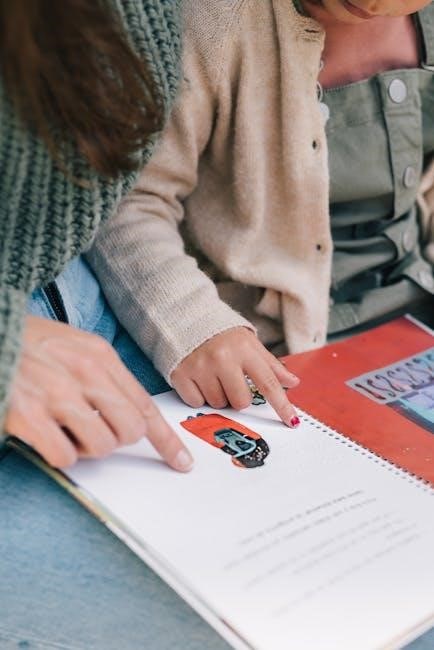Parents play a vital role in fostering a love of reading in their children. This guide offers practical advice and resources. Learn how to create a reading-rich home and use fun activities to build strong literacy skills with enthusiasm and enjoyment.
Reading is a fundamental skill that significantly impacts a child’s future success, even predicting income decades later. Parental involvement is crucial, with children read to from birth often starting school with larger vocabularies and a greater interest in reading. Parents are children’s first teachers, and their support at home can greatly enhance literacy development.
This guide empowers parents to actively participate in their child’s reading journey. It emphasizes that teaching reading doesn’t have to be complicated and that everyday activities can be used to practice reading skills. Creating a positive and collaborative reading environment is key, encouraging children to become avid and voracious independent readers at any age.
Early teaching is not harmful; in fact, it’s beneficial. Reading to children from a young age builds their vocabulary and sets them up for a bright educational future. By understanding the importance of parental involvement and implementing simple strategies, parents can make a lasting impact on their child’s literacy skills and foster a lifelong love of reading.

This introduction sets the stage for the guide, highlighting the profound impact of parental involvement on a child’s reading development and encouraging parents to take an active role in nurturing their child’s literacy skills from an early age. It emphasizes that parents can make a significant difference by creating a supportive and engaging reading environment at home.
Creating a Reading-Rich Environment at Home

Transforming your home into a haven for readers is essential for fostering a love of books and enhancing literacy skills. Make reading materials readily available and appealing to your child’s interests. Consider their natural curiosity and find topics they are passionate about. The more engaging the content, the more motivated they will be to work at their literacy skills. Sharpen reading skills with workbooks.
Create a quiet, special place dedicated to reading and writing. This designated space will help your child associate reading with relaxation and enjoyment. Take children’s books and writing materials with you whenever you leave home, providing fun and engaging activities during travel or appointments. Make reading the most attractive activity.
Read aloud to your child regularly, even after they learn to read independently. This exposes them to a wider range of vocabulary and demonstrates the joy of reading. Encourage reading choice, allowing them to select books that pique their interest. This fosters a sense of ownership and makes reading a more enjoyable experience. Start small with dedicated reading time.
By creating a reading-rich environment, you are sending a powerful message about the importance of literacy. Make reading a regular part of your family life, and watch your child’s love of books blossom. Remember to be patient and supportive, praising their efforts and celebrating their progress. Create positive experiences to help them enjoy reading.
Practical Strategies for Teaching Reading Skills
Teaching reading skills at home doesn’t need to be complicated. One of the best ways to teach reading strategies is to model them. This means showing your child how to use the strategy while sharing a story. Start by introducing letters and sounds, then gradually move to simple words and sentences. Focus on letter sounds over letter names. It is important to start the reading journey today.
Utilize everyday activities to help your child practice their reading skills. Point out print elements in the environment, such as signs, labels, and menus. Talk to your infant and toddler. Play rhyming games and sing silly songs to help your child learn about language. Create a positive collaborative reading ethos. Learning to read takes practice.
When reading a book where the print is large, point word by word as you read. Differentiate between illustrations and words. Incorporate phonics into your teaching; Structured literacy has proven to be the best evidence-based way to teach kids how to read. Get more advanced and look at rhyming or alliteration.
Encourage your child to read. Read aloud regularly and take turns reading. Be patient and provide praise. If your child tries to write a word and gets a letter wrong, they still deserve praise. Discover how to support your childs growth as a young reader and writer. By implementing these strategies, you can create a supportive and effective learning environment at home.
Making Reading Fun and Engaging
To make reading an engaging and rewarding experience, incorporate games, songs, and interactive reading activities focused on phonics and vocabulary. Find topics that are relatable to your child. The more engaging the content, the more your child will be motivated to work at their literacy skills. Loving to read takes enthusiasm.
Create a comfortable environment for reading. Choose a favourite time to read together as a family and enjoy it. This might be everyone reading the same book together, reading different things at the same time, or getting your children to read to each other. Read aloud regularly and take turns.
Don’t force them. Create a positive experience. Schedule dedicated reading time and start small. Use visual reinforcement to make reading more interactive. Ask kids questions that start with who, what, when, where, how, and why. Ask them to predict what will happen next and what in the text makes them think that.
Take childrens books and writing materials with you whenever you leave home. This gives your child fun activities to entertain and occupy him or her while traveling and going to the doctors office or other appointments. Create a quiet, special place in your home for your child to read, write, and explore the world of books. Read many stories with rhyming words and lines that repeat. Discuss new words.
Understanding Phonics and Letter Sounds
Focus on letter sounds over letter names to build strong foundational reading skills. Begin with uppercase letters. Structured literacy has proven to be the best evidence-based way to teach kids how to read. You can then get more advanced and look at rhyming or alliteration.
Start by introducing letters and sounds, then gradually move to simple words and sentences. Learning to read takes practice. Make reading materials ones they will truly care about readily available for your child. Kids threshold for boredom has appeared to lower in recent decades, particularly with todays access to social media and video streaming. If we want kids to engage in reading and writing, we need to make it the most attractive activity for them.
Incorporate phonics into your reading activities. Some parents think that only teachers can teach reading to children. But parents can, too. Reading is an essential life skill. Be patient. If your child shows no interest in a book, dont force it. If your child tries to write a word and gets a letter wrong, they still deserve praise.
Get FREE handouts, parent letters, and videos to help parents learn about the Science of Reading and explain how they can help at home. Watch the video below to learn more about the importance of early literacy. Discover what it takes to build important literacy skills, and how you can help your children grow as readers, writers, and thinkers!
Utilizing Everyday Activities for Reading Practice
Teaching reading strategies at home doesnt need to be complicated. You can use everyday activities to help your child practice their reading skills. One of the best ways to teach reading strategies is to model them. This means showing your child how to use the strategy while sharing a story. Plus, its hard to share the entire learning-to-read process in one tiny conversation.
Take childrens books and writing materials with you whenever you leave home. This gives your child fun activities to entertain and occupy him or her while traveling and going to the doctors office or other appointments. Create a quiet, special place in your home for your child to read, write.
Talk to your infant and toddler. Play rhyming games and sing silly songs to help your child learn about language. Read to your child every day, even when. Learn 9 fun tips to teach your child to read. Focus on letter sounds, blend phonics, and make learning enjoyable. Start the reading journey today!

Point out the cover and title of the book. Differentiate between illustrations and words. Ask your child to point out print elements. Talk. Browse our library of evidence-based teaching strategies, learn more about using classroom texts, find out what whole-child literacy instruction looks like, and dive deeper into comprehension, content area literacy, writing, and social-emotional learning;
Working with the School and Teachers
Parents are more concerned about their child’s progress in reading than in any other subject taught in school, and rightfully so. Discover how to support your childs growth as a young reader and writer with our Reading 101 for Families guide, bilingual parent tips, ideas for building your childs knowledge of the world, Qamp;A with experts, and guidance on connecting with your childs school. Visit the Literacy at Home Overview Word learning is an ongoing process. Children are always adding to their word banks in order to recognize and understand the meaning of spoken and written words.
Its hard to know how to help if your child is having a hard time reading. Learn how to talk with the school and what you can do at home. Some parents think that only teachers can teach reading to children. But parents can, too. Reading is an essential life skill. Be patient. If your child shows no interest in a book, dont force it. If your child tries to write a word and gets a letter wrong, they still deserve praise. How can teachers encourage parents and carers to engage in reading with their child?
Use these teacher tips to provide parents with support and tools to build their childàs literacy skills and help keep your students learning at home. This printable letter is a nice way to send home some quick tips to your students parents. Parents are very motivated to help their children.

Resources and Support for Parents
Parents often ask how they can help their children learn to read; and its no wonder that theyre interested in this essential skill. Reading plays an important role in later school success. One study even demonstrates that how well 7-year-olds read predicts their income 35 years later! Here are 11 practical recommendations for helping preschoolers and school-age students learn to read. Sometimes, parents are told early teaching is harmful, but it isnt true. You simply cant introduce literacy too early. I started reading to my own children on the days they were each born! First things first, teaching reading strategies at home doesnt need to be complicated.
Our one-page Reading Tip Sheets are available in thirteen languages and offer ideas for parents to help kids become successful readers. Although weve divided these tips by age, many of them can be used with children at various ages and stages we encourage you to choose the ones that work best for your child. These tips were created with the generous support of the American Federation of Teachers. Get FREE handouts, parent letters, amp; videos to help parents learn about the Science of Reading amp; explain how they can help at home. Explore AECFs latest findings on how parents can support their childrens literacy development. Learn how you can set your child up for success.
CDEs Literacy team aims to provide for parents and caregivers to access engaging resources, tips, and activities that can further help with your childs love of reading. Parents are childrens first teachers….Discover how to support your childs growth as a young reader and writer with our Reading 101 for Families guide, bilingual parent tips, ideas for building your childs knowledge of the world, Qamp;A with experts, and guidance on connecting with your childs school.
